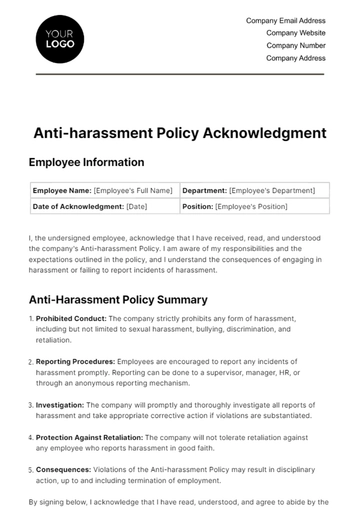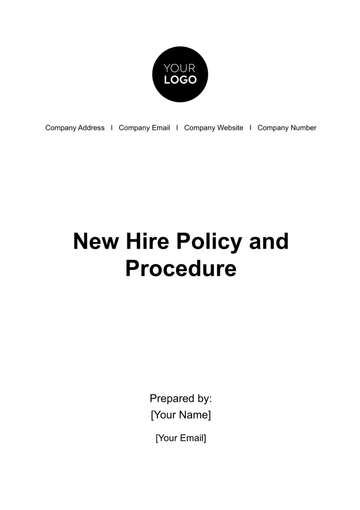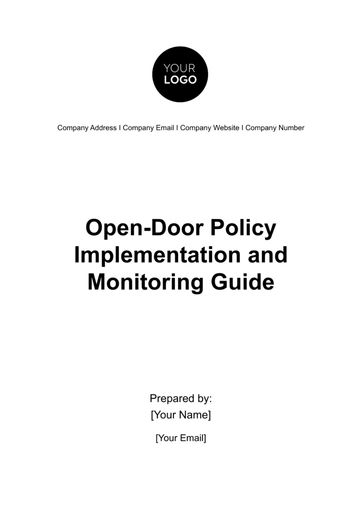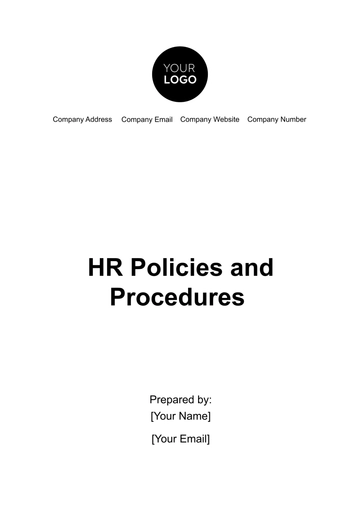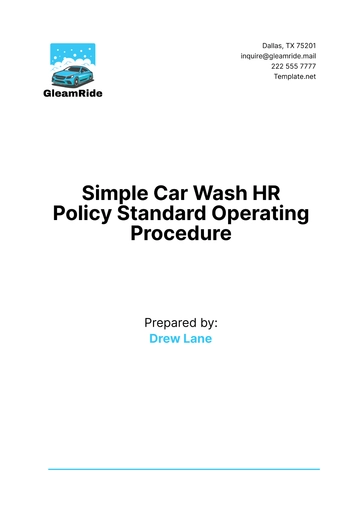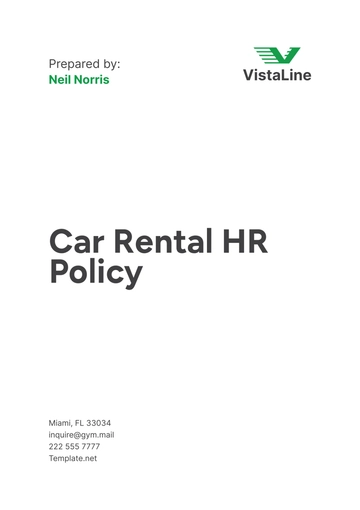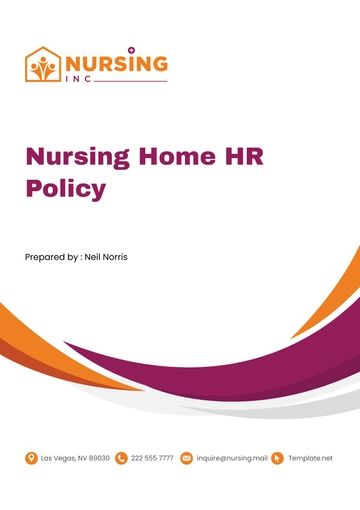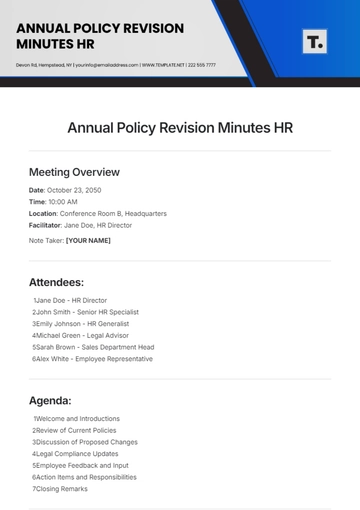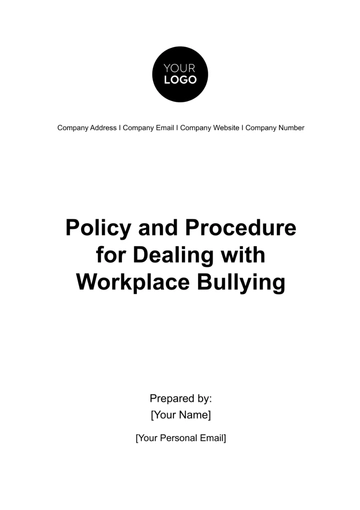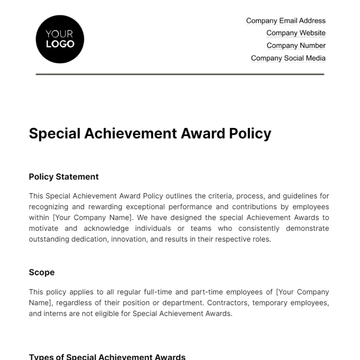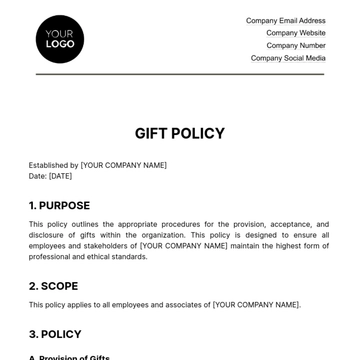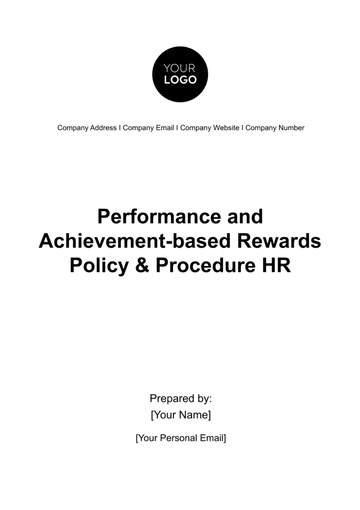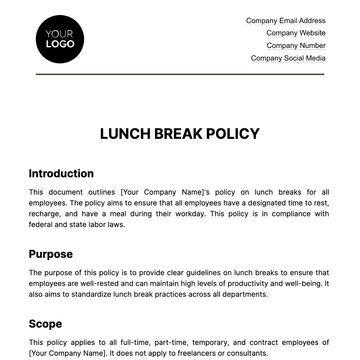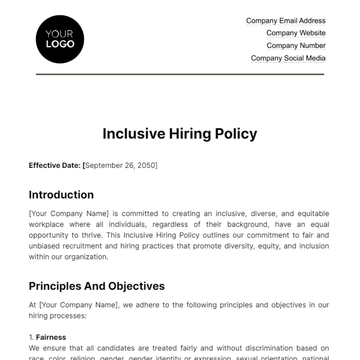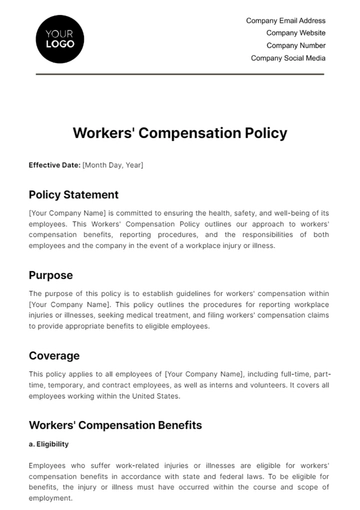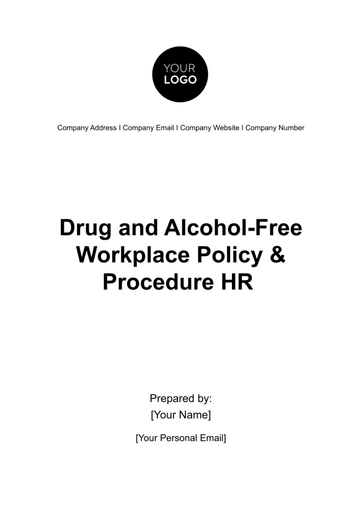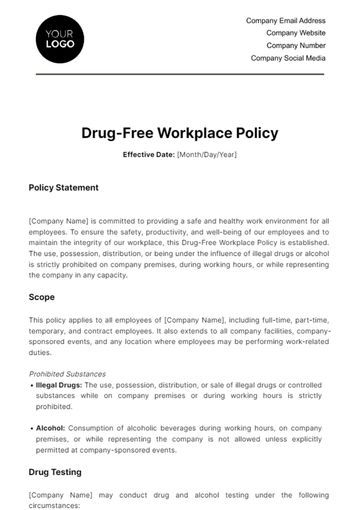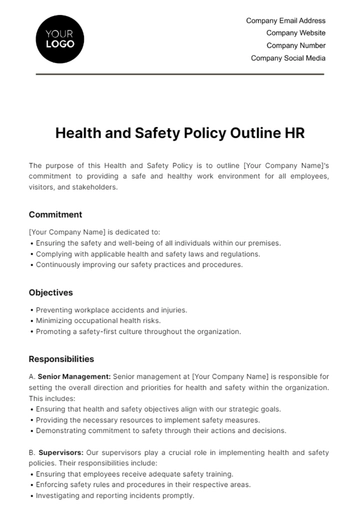Free Nursing Home HR Policy
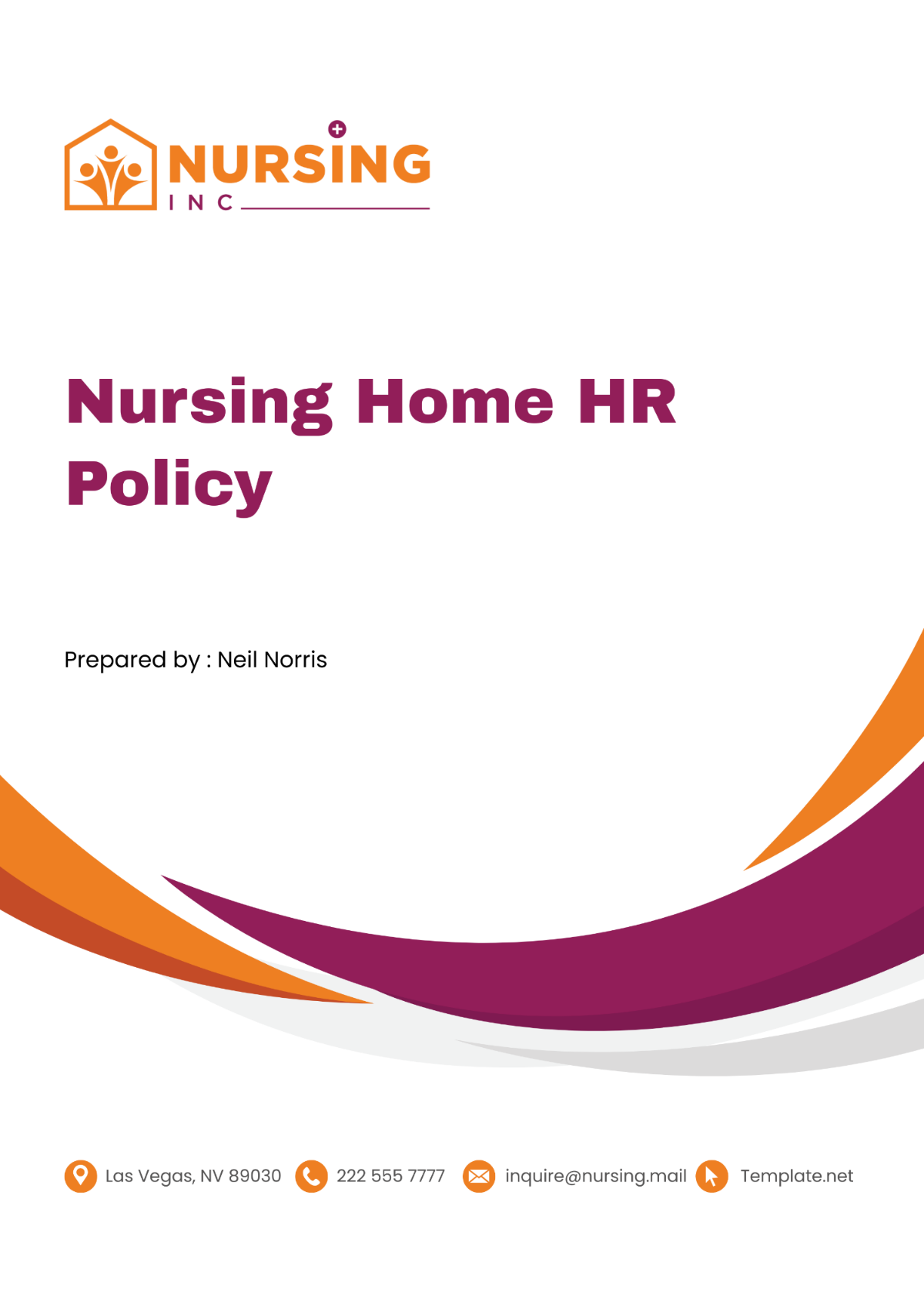
I. Introduction
A. Purpose of the Policy
Guidelines for Behavior and Conduct: This policy provides clear guidelines for all employees on the standards of behavior and conduct expected by [Your Company Name]. It helps to ensure that all employees understand what is expected of them and what they can expect from [Your Company Name].
Understanding Rights and Responsibilities: The policy also helps employees understand their rights and responsibilities. This includes their rights to a safe and respectful workplace, and their responsibilities to contribute to such an environment.
Promoting a Positive Work Environment: The policy promotes a positive, respectful, and safe work environment for everyone. It sets out the standards of behavior that will help to create such an environment.
Ensuring Legal Compliance: The policy ensures compliance with all relevant laws and regulations. It provides guidance on how to comply with these laws in the day-to-day operations of the nursing home.
B. Scope of the Policy
Applicability to All Employees: This policy applies to all employees of [Your Company Name], regardless of their position or length of service. It sets out the standards of behavior and conduct that all employees are expected to follow.
Applicability to Contractors and Volunteers: This policy also applies to contractors, volunteers, and anyone else who is temporarily assigned to work for [Your Company Name]. It helps to ensure that everyone who works for [Your Company Name] is treated with respect and dignity.
Applicability to All Aspects of Employment: This policy applies to all aspects of employment, including recruitment, selection, training, promotion, performance management, and termination. It helps to ensure that all employment practices are fair and equitable.
In Effect at All Times: This policy is in effect at all times while employees are conducting business, both during regular business hours and at [Your Company Name]-related events that occur outside of regular business hours.
C. Policy Review and Updates
Annual Review: This policy will be reviewed annually to ensure that it continues to meet the needs of [Your Company Name] and its employees. This will involve consulting with employees and other stakeholders, and considering any changes in the law or in the operating environment of the nursing home.
Notification of Changes: Employees will be notified of any changes to the policy in a timely manner. This will ensure that all employees are aware of the current policy and understand what is expected of them.
Feedback from Employees: Employees are encouraged to provide feedback on this policy at any time. This helps to ensure that the policy remains relevant and effective, and that it continues to meet the needs of employees.
Consultation with Stakeholders: Any changes to this policy will be made in consultation with relevant stakeholders, including employee representatives and legal advisors. This helps to ensure that the policy is fair, equitable, and legally compliant.
Availability of the Policy: The most current version of this policy will always be available to employees for reference. This helps to ensure that all employees have easy access to the policy and can refer to it as needed.
D. Compliance with the Policy
Expectation of Compliance: All employees are expected to comply with this policy at all times. This helps to ensure that [Your Company Name] is a positive, respectful, and safe place to work.
Consequences of Non-Compliance: Failure to comply with this policy may result in disciplinary action, up to and including termination of employment. This helps to ensure that any breaches of the policy are dealt with appropriately.
Reporting Policy Violations: Any employee who feels that this policy has been violated should report the matter to their supervisor or to the HR department. This helps to ensure that any issues are addressed promptly and effectively.
Investigation of Reports: All reports of policy violations will be taken seriously and investigated promptly and impartially. This helps to ensure that all employees feel confident in reporting any issues, and that those issues are dealt with fairly.
II. Employment Policies
A. Equal Opportunity Employment
Commitment to Equality: The nursing home is committed to providing equal employment opportunities for all individuals. This commitment means that all employment decisions at the facility are based on business needs, job requirements, and individual qualifications, without regard to race, color, religion, sex, national origin, age, disability, or any other characteristic protected by law.
Non-Discrimination: The nursing home does not discriminate in employment opportunities or practices. This applies to all aspects of employment, including hiring, promotion, termination, and access to benefits and training.
Reasonable Accommodation: The nursing home makes reasonable accommodations for qualified individuals with disabilities, unless doing so would cause undue hardship. This is part of the commitment to creating an inclusive workplace where everyone can succeed.
Complaint Procedure: Employees who believe they have been the victims of discrimination are encouraged to bring these issues to the attention of their immediate supervisor or the Human Resources Department. The nursing home is committed to resolving these issues in a timely and effective manner.
B. Recruitment and Selection
Job Posting: All available job openings at the nursing home are posted internally for a period of five business days. Current employees interested in a posted job opening should notify the Human Resources Department.
Application: All applicants must complete an application form. This helps the nursing home gather consistent information about all candidates and ensure that all applicants are considered on an equal basis.
Interview: The hiring manager will interview applicants whose experience and skills match the requirements of the job opening. Second interviews may be required for final candidates.
Selection: The selection process at the nursing home is carried out in a manner that promotes equal employment opportunity and prohibits unlawful discrimination.
C. Probationary Period
Purpose: The probationary period is intended to give new employees the opportunity to demonstrate their ability to achieve a satisfactory level of performance. It also gives the nursing home the opportunity to evaluate the new employee’s fit within the company.
Duration: The nursing home uses a probationary period of 90 days to evaluate employee capabilities, work habits, and overall performance.
Evaluation: At the end of the probationary period, the supervisor will review the employee’s job performance and recommend regular employment, extension of the probationary period, or termination.
D. Employee Records
Confidentiality: Employee records at the nursing home are confidential and access to the records is restricted. Generally, only supervisors and management personnel who have a legitimate reason to review information in a file are allowed to do so.
Accuracy: Employees are responsible for notifying the nursing home of any changes in personal data. This helps the nursing home keep its records accurate and up-to-date.
Access: Employees may review their own personnel files by contacting the Human Resources Department.
Retention: The nursing home will retain and dispose of personnel records in accordance with legal requirements.
III. Compensation and Benefits
A. Payroll Information
Pay Periods: The nursing home operates on bi-weekly pay periods. Employees will receive their paychecks every other Friday, accounting for the work performed in the previous two weeks.
Direct Deposit: For convenience and security, the nursing home offers direct deposit. Employees can have their paychecks deposited directly into their bank accounts on payday.
Payroll Deductions: Mandatory deductions, such as taxes and social security, as well as voluntary deductions for benefits, will be itemized on the employee’s paycheck stub.
B. Work Hours and Overtime
Standard Work Hours: The standard work week for full-time employees at the nursing home is 40 hours. Work schedules may vary based on the department and job function.
Overtime Compensation: Any hours worked in excess of 40 hours per week will be considered overtime and will be compensated at one and a half times the employee’s regular hourly rate, in accordance with federal and state labor laws.
Overtime Authorization: All overtime work must be authorized in advance by a supervisor. Unauthorized overtime will not be compensated.
C. Leave Policies
The nursing home recognizes the importance of work-life balance and has established a comprehensive leave policy to support this. The following table provides an overview of the leave policies:
Type of Leave | Description | Number of Days |
|---|---|---|
Annual Leave | Paid leave for vacations or personal needs. | 10-20 days per year |
Sick Leave | Paid leave for times when an employee is unable to work due to illness or injury. | 5-10 days per year |
Family and Medical Leave | Unpaid leave for certain family and medical reasons. | Up to 12 weeks per year |
Bereavement Leave | Paid leave granted in the event of the death of an immediate family member. | 3-5 days per event |
Annual Leave: This type of leave is crucial for maintaining a healthy work-life balance. It allows employees to take time off for rest, relaxation, and personal activities. By doing so, it can lead to increased productivity and job satisfaction when they return to work.
Sick Leave: Sick leave ensures that employees can take the necessary time off to recover when they are ill or injured, without worrying about loss of income. This is not only beneficial for the employee’s health, but also for the overall work environment as it helps to prevent the spread of illness and ensures that employees are at their best when they are at work.
Family and Medical Leave: This type of leave is important for supporting employees through significant life events, such as the birth or adoption of a child or a serious illness in the family. By providing this leave, the nursing home shows its support for its employees’ wellbeing and its understanding of their outside responsibilities.
Bereavement Leave: Bereavement leave provides employees with the time they need to grieve and take care of related matters in the event of the death of an immediate family member. This is an important part of supporting employees’ emotional wellbeing during a difficult time.
These leave policies play a crucial role in supporting the wellbeing of employees, promoting a positive work environment, and ensuring compliance with labor laws. They reflect the nursing home’s commitment to its employees and its understanding of their needs and challenges. By providing these benefits, the nursing home can help to attract and retain a dedicated and satisfied workforce.
D. Employee Benefits
The nursing home offers a comprehensive benefits package to support the health, well-being, and financial security of its employees. The following table provides an overview of the key components of this benefits package:
Benefit | Description |
|---|---|
Health Insurance | Comprehensive health insurance coverage, including medical, dental, and vision. |
Retirement Plan | A 401(k) plan to help employees save for retirement. |
Life Insurance | Life insurance coverage to provide financial security for employees’ families. |
Paid Time Off | Paid time off for vacations, illness, and personal needs. |
Professional Development | Opportunities for professional development, including training and education programs. |
Health Insurance: Health insurance is a crucial part of the benefits package. It provides coverage for a wide range of healthcare services, helping to protect employees from high medical costs. The inclusion of dental and vision coverage ensures that employees have access to comprehensive healthcare services.
Retirement Plan: The 401(k) plan allows employees to save for retirement in a tax-advantaged manner. This is an important benefit as it helps to ensure the financial security of employees in their retirement years.
Life Insurance: Life insurance provides a financial safety net for employees’ families in the event of the employee’s death. This can help to cover funeral costs, pay off debts, and provide an income for dependents.
Paid Time Off: Paid time off allows employees to take time off from work for vacations, illness, or personal needs. This is an important benefit as it supports work-life balance and can contribute to improved employee health and productivity.
Professional Development: The nursing home is committed to the ongoing professional development of its employees. This includes providing opportunities for training and education, which can help employees to enhance their skills, increase their job satisfaction, and advance their careers.
These benefits play a crucial role in attracting and retaining a skilled and satisfied workforce. They demonstrate the nursing home’s commitment to its employees and contribute to a positive and supportive work environment. By investing in its employees in this way, the nursing home can enhance its reputation, improve employee morale, and ultimately deliver a higher standard of care to its residents.
IV. Performance Management
A. Performance Reviews
Annual Reviews: The nursing home conducts performance reviews on an annual basis. These reviews provide an opportunity for employees and their supervisors to discuss job tasks, identify and correct weaknesses, encourage and recognize strengths, and discuss positive, purposeful approaches for meeting goals.
Mid-Year Check-Ins: In addition to the annual review, supervisors may conduct informal check-ins with employees throughout the year. These check-ins provide an opportunity to discuss progress towards goals, address any issues or concerns, and provide ongoing feedback.
Performance Improvement Plans: If an employee’s performance is found to be unsatisfactory, the supervisor may develop a Performance Improvement Plan (PIP). The PIP will outline specific areas for improvement and will include a timeline for achieving these improvements.
B. Employee Recognition
Recognition Program: The nursing home has an employee recognition program to acknowledge and reward employees for exceptional performance and contributions to the nursing home.
Nomination Process: Employees are encouraged to nominate their peers for recognition. The nomination process is simple and can be done through a form provided by the HR department.
Awards: Recognition awards can take many forms, including certificates, plaques, or gift cards. The type of award will depend on the nature of the achievement.
V. Workplace Conduct
A. Code of Conduct
Professionalism: All employees are expected to conduct themselves in a professional manner at all times. This includes treating residents, their families, and colleagues with respect and dignity.
Ethical Behavior: Employees are expected to act ethically at all times. This includes avoiding conflicts of interest, respecting the privacy of residents, and maintaining the confidentiality of sensitive information.
Compliance with Laws and Regulations: Employees must comply with all applicable laws and regulations, including those related to healthcare, employment, and safety. Any suspected violations should be reported immediately to a supervisor or the Human Resources Department.
Use of Property: Employees must use the nursing home’s property responsibly and for legitimate business purposes. This includes equipment, supplies, and facilities.
Substance Abuse: The nursing home is committed to maintaining a drug-free workplace. The use, possession, or distribution of illegal drugs or alcohol is strictly prohibited.
B. Conflict Resolution
Open Communication: The nursing home encourages open communication and dialogue. If an employee has a conflict or disagreement with a colleague, they are encouraged to address it directly in a respectful and constructive manner.
Mediation: If a conflict cannot be resolved directly, the parties involved can request mediation. The Human Resources Department can provide a neutral third party to facilitate this process.
Reporting: If an employee feels uncomfortable addressing a conflict directly, or if a conflict involves harassment or discrimination, it should be reported to a supervisor or the Human Resources Department.
Non-Retaliation: The nursing home prohibits retaliation against any employee who reports a conflict or participates in a conflict resolution process.
C. Harassment and Discrimination
Zero Tolerance Policy: The nursing home has a zero-tolerance policy for harassment and discrimination. This includes any form of behavior that creates an intimidating, hostile, or offensive work environment.
Reporting: Any employee who experiences or witnesses harassment or discrimination should report it immediately to a supervisor or the Human Resources Department.
Investigation: All reports of harassment or discrimination will be taken seriously and investigated promptly and impartially.
Disciplinary Action: Any employee found to have engaged in harassment or discrimination will be subject to disciplinary action, up to and including termination of employment.
Non-Retaliation: The nursing home prohibits retaliation against any employee who reports harassment or discrimination or participates in an investigation.
VI. Health and Safety
A. Workplace Safety
Commitment to Safety: The nursing home is committed to providing a safe and healthy work environment for all employees. This commitment is a core part of the nursing home’s values and operations.
Safety Training: All employees receive regular training on workplace safety practices and procedures. This training includes specific instructions on how to perform their duties in a manner that minimizes risk.
Reporting of Hazards: Employees are encouraged to report any workplace hazards or safety concerns to their supervisor or the Human Resources Department. The nursing home takes all reports seriously and will take prompt action to investigate and rectify any hazards.
Emergency Procedures: The nursing home has established emergency procedures to follow in the event of various types of incidents, including fires, medical emergencies, and natural disasters. These procedures are communicated to all employees and regular drills are conducted to ensure readiness.
Personal Protective Equipment: Where necessary, the nursing home provides employees with personal protective equipment (PPE) to help prevent workplace injuries. Employees are trained on the correct use of PPE and are required to use it as directed.
B. Emergency Procedures
Emergency Plan: The nursing home has a comprehensive emergency plan that outlines the procedures to follow in the event of various types of emergencies, including fires, medical emergencies, and natural disasters.
Training: All employees receive training on the emergency plan and are expected to understand their roles and responsibilities in the event of an emergency.
Drills: The nursing home conducts regular emergency drills to ensure that all employees know what to do in an actual emergency situation.
Review and Update: The emergency plan is reviewed and updated regularly to ensure its effectiveness and relevance.
C. Health and Wellness
Wellness Program: The nursing home offers a wellness program that includes resources and activities designed to support employees’ physical and mental health.
Health Screenings: Regular health screenings are offered to employees to help detect potential health issues early.
Mental Health Resources: The nursing home recognizes the importance of mental health and provides resources to support employees, including access to counseling services.
Healthy Work Environment: The nursing home strives to create a work environment that promotes healthy habits, including regular breaks, access to healthy food options, and opportunities for physical activity.
Accommodations for Disabilities: The nursing home is committed to making reasonable accommodations for employees with disabilities to enable them to perform their job duties effectively and safely.
VII. Training and Development
A. Orientation and Onboarding
Orientation Program: The nursing home provides a comprehensive orientation program for all new employees. This program introduces them to the nursing home’s culture, policies, and procedures, and ensures they have the information they need to succeed in their roles.
Onboarding Process: The onboarding process at the nursing home is designed to help new employees transition smoothly into their roles. This includes an introduction to their team, a tour of the facility, and training on job-specific tasks.
Mentorship: New employees are paired with a mentor who can provide guidance and support as they navigate their first few months at the nursing home. This mentorship relationship can be a valuable source of learning and development for new employees.
Evaluation: The effectiveness of the orientation and onboarding process is regularly evaluated and updated based on feedback from new employees and their supervisors.
B. Professional Development
Continuous Learning: The nursing home is committed to supporting the continuous learning and professional development of its employees. This includes providing access to training programs, workshops, and conferences that can enhance their skills and knowledge.
Performance Reviews: Performance reviews are used not only to assess past performance, but also to identify areas for future development. Employees and their supervisors work together to set development goals and create a plan to achieve them.
Career Advancement: The nursing home supports the career advancement of its employees by providing opportunities for promotion and lateral movement within the organization. Employees are encouraged to express their career goals and aspirations to their supervisors.
Succession Planning: The nursing home has a succession planning process in place to identify and develop employees who have the potential to fill key leadership roles in the future. This process helps ensure the long-term success of the nursing home.
- 100% Customizable, free editor
- Access 1 Million+ Templates, photo’s & graphics
- Download or share as a template
- Click and replace photos, graphics, text, backgrounds
- Resize, crop, AI write & more
- Access advanced editor
Ensure compliance in your nursing home with the Nursing Home HR Policy Template from Template.net! This editable template covers a wide range of human resources policies and procedures, providing clear guidelines for staff members and managers alike. With our AI Editor Tool, this template is customizable to match your needs!
You may also like
- HR Policy
- Restaurant Policy
- Company Policy
- Accounting Policies and Procedures
- Website Policy
- Privacy Policy
- Safety Policy
- School Policy
- IT and Software Policy
- Law Firm Policy
- Construction Policy
- Interior Design Policy
- Travel Agency Policy
- Education Academic Policy
- Security Policy
- Real Estate Policy
- Expense Policy
- Software Policy
